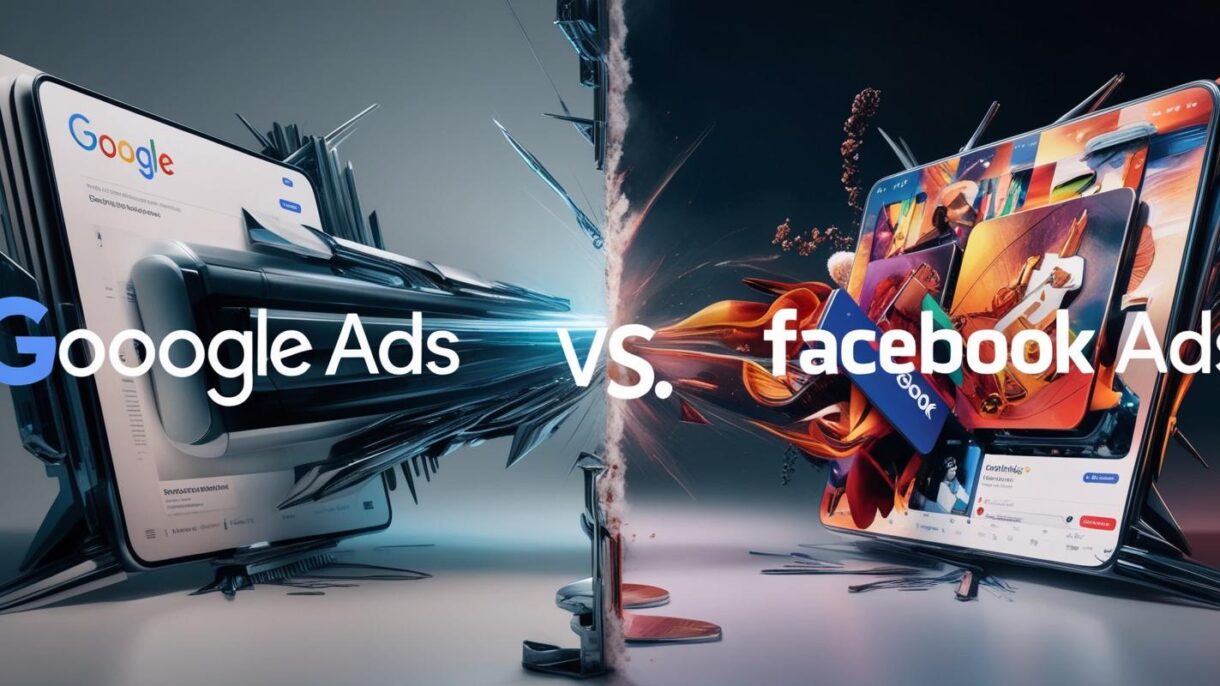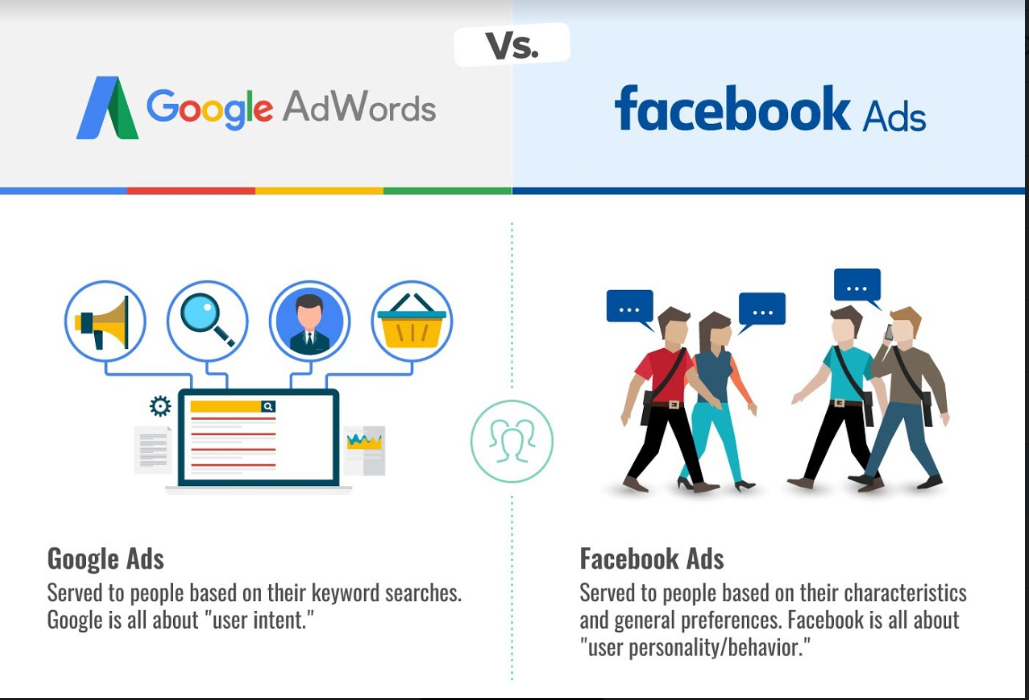
In the heart of bustling Indian cities and the quiet corners of rural towns, a silent revolution is underway. Businesses-big and small-are locked in a fierce battle for attention, relevance, and growth. The digital age has democratized access to customers, but it has also made the marketplace more crowded and competitive than ever before. The challenge? Every rupee spent on marketing must count. Yet, many businesses find themselves lost in a maze of choices, wondering: Should I invest in Google Ads or Facebook Ads? Which platform will give me the best return on investment (ROI)? The answer to this question is not as straightforward as it seems, and the stakes are high. In a world where consumer attention is fleeting and competition is relentless, making the right marketing decision can be the difference between soaring success and missed opportunities. But as we’ll discover, the real solution lies not in choosing one platform over the other, but in embracing a holistic, growth-driven approach that goes beyond mere performance marketing.
Table of Contents
Sr. Headings
1. Introduction: The Modern Marketing Dilemma
2. Google Ads vs. Facebook Ads: The ROI Debate
3. Why Performance Marketing Alone Isn’t Enough
4. The Power of Growth Marketing and Influencer Strategies
5. Nurturing Talent: The Role of OCP Academy in 2025
6. Case Study: Full-Stack Success in the Indian Market
7. The Impact of Integrated Digital Marketing
8. The Evolution of the Indian Digital Consumer
9. The Hidden Costs of Over-Reliance on a Single Platform
10. The Emotional Power of Storytelling in Indian Marketing
11. The Rise of Vernacular Content and Regional Influencers
12. The Importance of Data-Driven Decision Making
13. Building a Sustainable Digital Marketing Ecosystem
14. Preparing for the Future: The Role of Lifelong Learning
15. Conclusion: The Path Forward for Indian Businesses
16. Frequently Asked Questions (FAQ)

Google Ads vs. Facebook Ads: The ROI Debate
The debate between Google Ads and Facebook Ads is as old as digital marketing itself. Both platforms have their unique strengths and cater to different stages of the customer journey. Google Ads, with its vast search network, taps into active intent. When someone types “best running shoes in Mumbai” into Google, they’re already signaling a desire to buy. This high purchase intent often translates into higher conversion rates-studies show Google Ads can have conversion rates slightly higher than Facebook Ads, with averages around 7.26% compared to Facebook’s 6.57%.. For Indian brands like Juicy Chemistry, leveraging Google Ads has led to a threefold increase in their user base and a 20% jump in sales, thanks to targeted keywords and compelling ad content.
On the other hand, Facebook Ads excel at building awareness and nurturing relationships. With over 1.73 billion daily active users worldwide (and a massive footprint in India), Facebook’s strength lies in its ability to target users based on demographics, interests, and behaviors. This makes it ideal for brands looking to create demand, foster engagement, and build communities. Facebook’s dominance in mobile advertising also means it’s often the first touchpoint for India’s rapidly growing mobile-first population. However, while Facebook can drive impressive reach and engagement, its conversion rates may lag slightly behind Google’s, especially for high-intent searches.
Yet, the question remains: Which platform offers better ROI for Indian businesses in 2025? The answer depends on your goals, audience, and the stage of your customer’s journey. Google Ads shine when you want to capture ready-to-buy customers, while Facebook Ads are unbeatable for brand building and long-term engagement. But relying solely on one platform-or even just on performance marketing-can be a costly mistake.
Why Performance Marketing Alone Isn’t Enough
Performance marketing has transformed the Indian advertising landscape. With its pay-per-action model, businesses only pay for tangible results-be it clicks, leads, or sales. This approach is data-driven, measurable, and cost-efficient, making it incredibly attractive in a market where every rupee matters.. Agencies across India have mastered the art of optimizing campaigns in real-time, ensuring that marketing budgets are spent wisely and efficiently.
However, performance marketing is not a silver bullet. The digital ecosystem is evolving at breakneck speed, and consumer behavior is becoming more complex. Relying solely on Google or Facebook ads can lead to diminishing returns. Data overload, ad fatigue, and rising competition are real challenges.Moreover, performance marketing often focuses on short-term wins-immediate clicks or conversions-at the expense of long-term brand equity and customer loyalty. In a country like India, where relationships and trust play a pivotal role in purchasing decisions, this approach can be limiting.
True, performance marketing delivers measurable results, but it’s just one piece of the puzzle. To thrive in 2025 and beyond, Indian businesses need to think bigger. They need to embrace growth marketing-a holistic approach that combines performance, brand building, content, and influencer strategies to drive sustainable success.
The Power of Growth Marketing and Influencer Strategies
Growth marketing is the art and science of building brands that last. It’s about looking beyond immediate conversions and focusing on the entire customer journey-from awareness to advocacy. In India, where digital marketing is growing at an astonishing 23.49% annually and the market is projected to reach INR 62,045 crore by the end of 2025, the stakes have never been higher. Growth marketing leverages the power of storytelling, community building, and data-driven experimentation to create lasting impact.
One of the most powerful tools in the growth marketer’s arsenal is influencer marketing. In 2024 and 2025, influencer campaigns have become the heartbeat of brand strategies in India. Brands like BoAt, Zomato, and Nykaa have harnessed the power of influencers to craft stories, build communities, and create experiences that resonate deeply with Indian audiences. Influencers bring authenticity, trust, and relatability-qualities that are often missing in traditional ads. They help brands break through the noise, reach niche audiences, and drive not just awareness, but real engagement and loyalty.
Growth marketing also means integrating multiple channels-SEO, content, email, social media, and paid ads-into a cohesive strategy. This integrated approach ensures that your brand is visible at every stage of the customer journey, maximizing touchpoints and reinforcing your message across platforms. It’s not about choosing Google Ads or Facebook Ads; it’s about orchestrating both, along with other channels, to create a symphony of growth.
Nurturing Talent: The Role of OCP Academy in 2025
As the digital landscape becomes more complex, the need for skilled marketers has never been greater. This is where institutions like OCP Academy step in, playing a pivotal role in shaping the future of Indian businesses. OCP Academy, a leader in digital marketing education, is preparing students and professionals for the challenges of 2025 with its cutting-edge courses and hands-on learning approach.
The Academy’s curriculum is designed to reflect the latest trends and technologies, including artificial intelligence, data analytics, and emerging platforms. Students gain real-world experience through projects, mentorship from industry experts, and opportunities to network with leaders in the field. Flexible online learning options make it accessible to a diverse range of learners, from fresh graduates to working professionals.
OCP Academy doesn’t just teach digital marketing; it nurtures growth marketers-professionals who understand the importance of integrated strategies, ethical practices, and customer-centricity. With recognized certifications and robust career support, graduates are equipped to drive business growth and innovation in India’s fast-evolving digital economy.
Case Study: Full-Stack Success in the Indian Market
To truly understand the power of integrated digital marketing, let’s look at a real-world example from India. A real estate company in Kolkata faced significant challenges: no website, no social media presence, steep competition, and a limited budget. Partnering with a digital marketing agency, they embarked on a 360-degree campaign that combined SEO, pay-per-click (PPC) advertising, social media marketing, content creation, and email outreach.
The agency built a mobile-responsive website, optimized over 500 keywords, launched targeted blogs, and managed social media pages to maintain brand consistency. Facebook Ads were used to promote branding among the target audience, while Google Ads generated high-quality leads. The result? A significant increase in web traffic, a surge in inquiries, and a transformation from an unknown player to a leading real estate brand in Kolkata and beyond.
This case study highlights a crucial lesson: Success in digital marketing doesn’t come from choosing one platform or strategy. It comes from integrating multiple channels, adapting to market trends, and focusing on both short-term performance and long-term growth.

The Impact of Integrated Digital Marketing
The impact of integrated digital marketing in India by 2025 is nothing short of transformative, reshaping how brands connect with audiences and drive business growth in a rapidly evolving digital landscape. Integrated digital marketing brings together diverse channels-search, social media, email, content, influencer partnerships, and emerging technologies-into a unified strategy that amplifies each channel’s strengths and ensures a seamless, consistent brand experience for consumers. As India’s internet penetration surges and digital adoption accelerates, businesses are no longer limited to siloed campaigns or single-platform tactics; instead, they are empowered to reach wider audiences, maintain brand visibility, and engage customers at every stage of their journey.
The synergy created by integrating AI-powered personalization, voice search optimization, social commerce, and immersive content formats like video and augmented reality allows brands to deliver hyper-targeted, relevant, and memorable experiences that drive higher engagement and conversion rates.. With innovations such as programmatic advertising, connected TV, and location-based marketing, campaigns become more data-driven and measurable, enabling marketers to optimize for better returns on investment while minimizing waste.
Moreover, integrated strategies foster trust and authenticity, especially when combined with influencer marketing and vernacular content, helping brands build deeper relationships with India’s diverse and emotionally-driven consumers. The result is a robust digital marketing ecosystem where businesses can test new ideas with minimal risk, adapt quickly to emerging trends, and achieve sustainable growth in an increasingly competitive market. As we move further into 2025, those who embrace integrated digital marketing will not only future-proof their brands but also unlock unprecedented opportunities for innovation, engagement, and long-term success in the vibrant Indian marketplace.
The Evolution of the Indian Digital Consumer
Over the past decade, the Indian consumer has undergone a dramatic transformation, shaped by the proliferation of affordable smartphones, cheaper data plans, and the rise of regional content. Today’s digital-savvy Indian is no longer just a passive recipient of advertisements but an active participant in the buying journey. Whether it’s a college student in Pune searching for the latest gadgets or a homemaker in Lucknow exploring new recipes on Instagram, the Indian audience is diverse, discerning, and always connected. This evolution means that brands can no longer rely on a one-size-fits-all approach; they must adapt their messaging, creative, and targeting to resonate with different segments. Google Ads and Facebook Ads offer powerful targeting tools, but the real magic happens when brands use data-driven insights to craft campaigns that speak directly to the aspirations, languages, and lifestyles of their audiences. In this new era, understanding the Indian digital consumer is the first step toward achieving meaningful ROI.
The Hidden Costs of Over-Reliance on a Single Platform
Many Indian businesses, especially startups and SMEs, are tempted to pour all their marketing budgets into the platform that seems to deliver the fastest results. While this might yield quick wins, it often comes with hidden costs that can undermine long-term growth. For instance, relying solely on Google Ads might help you capture high-intent searchers, but you risk missing out on the massive brand-building potential that social platforms like Facebook and Instagram offer. Conversely, focusing only on Facebook Ads may boost engagement but could leave you struggling to convert that interest into actual sales. Moreover, both platforms are subject to algorithm changes, fluctuating ad costs, and increasing competition, which can quickly erode your ROI if you’re not diversified. The smartest Indian brands are those that hedge their bets, spreading their investments across multiple channels and continuously testing new strategies to stay ahead of the curve.
The Emotional Power of Storytelling in Indian Marketing
India is a land of stories, and the most successful brands are those that tap into this rich tradition. While performance marketing focuses on numbers and conversions, it often overlooks the emotional connection that drives real loyalty. Growth marketing, on the other hand, understands that every campaign is an opportunity to tell a story-whether it’s a small business owner sharing her journey on Facebook Live or a tech startup using Google Display Ads to showcase customer testimonials. Influencer collaborations, in particular, bring these stories to life, allowing brands to connect with audiences on a personal level. When a popular YouTuber or Instagram creator shares their genuine experience with a product, it resonates far more deeply than a generic ad. In a market as emotionally driven as India, storytelling isn’t just a nice-to-have; it’s a strategic imperative for brands seeking to build lasting relationships and maximize ROI.
The Rise of Vernacular Content and Regional Influencers
As internet penetration deepens across India’s Tier 2 and Tier 3 cities, the demand for content in regional languages is exploding. Google and Facebook have both invested heavily in supporting vernacular content, but the real breakthrough is coming from local influencers who speak the language of their communities. For brands, this presents a golden opportunity to reach new audiences in a way that feels authentic and relatable. Whether it’s a Bhojpuri singer promoting a new app on Facebook or a Tamil tech reviewer running Google Ads for a smartphone brand, regional influencers are helping to bridge the gap between brands and consumers. By incorporating vernacular content and partnering with local creators, Indian businesses can unlock new markets, drive engagement, and achieve better ROI than ever before.
The Importance of Data-Driven Decision Making
In the fast-paced world of Indian digital marketing, gut instinct is no longer enough. Every rupee spent must be justified with hard data, and every campaign must be optimized for maximum impact. Google Ads and Facebook Ads both offer sophisticated analytics tools, but the real value lies in how brands use this data to inform their strategies. From A/B testing ad creatives to analyzing customer journeys across platforms, data-driven decision making enables businesses to identify what’s working, eliminate waste, and double down on high-performing tactics. For example, an e-commerce brand might discover that its Google Ads are driving more conversions in metro cities, while Facebook Ads are more effective in rural areas. By continuously monitoring and adjusting their campaigns, Indian businesses can ensure they’re always getting the best possible ROI.
Building a Sustainable Digital Marketing Ecosystem
As the Indian digital economy matures, it’s becoming clear that sustainable growth requires more than just quick wins. Brands must invest in building a robust digital marketing ecosystem that includes not only paid advertising, but also organic search, content marketing, email automation, and customer relationship management. This holistic approach ensures that every interaction with the customer is meaningful, memorable, and consistent. Training institutions like OCP Academy are at the forefront of this movement, equipping marketers with the skills they need to manage complex, multi-channel campaigns. By fostering a culture of continuous learning and innovation, Indian businesses can future-proof themselves against the inevitable changes in technology and consumer behavior.
Preparing for the Future: The Role of Lifelong Learning
The digital landscape in India is changing at lightning speed, with new platforms, algorithms, and consumer trends emerging every year. To stay ahead, marketers must commit to lifelong learning and continuous upskilling. Institutions like OCP Academy are leading the way, offering courses that cover everything from the basics of Google and Facebook Ads to advanced topics like AI-driven marketing, data analytics, and influencer strategy. By investing in education and staying curious, Indian professionals can ensure that they’re ready to tackle whatever challenges the future may bring-and help their businesses achieve sustainable, long-term ROI.
These additional points deepen the discussion around your main topic, making your blog more comprehensive, relatable, and actionable for Indian readers seeking to excel in digital marketing.
FAQs


Yes, but it takes time, consistency, and strategy. Organic growth is slower but builds long-term value.
Absolutely, but they must be part of a larger funnel. Without a proper landing page or content support, ads alone won’t convert.
It’s a combination of all digital skills: content creation, paid ads, SEO, analytics, email, social, influencer, and more. It gives you a holistic view of marketing.
Enroll in practical, hands-on programs like those at OCP Academy. Choose mentors who’ve worked in the field, not just taught theory.
Yes! Even small brands can collaborate with micro-influencers who have high engagement and local trust.
Conclusion
The journey to digital marketing success in India is not a sprint; it’s a marathon. The debate between Google Ads and Facebook Ads is important, but it’s only the beginning. The real winners are those who see the bigger picture-who invest in growth marketing, nurture talent, and integrate multiple channels to create lasting impact. As India’s digital economy continues to soar, opportunities abound for those willing to innovate, adapt, and learn. Institutions like OCP Academy are lighting the way, equipping the next generation of marketers with the skills and mindset needed to thrive. Influencer marketing, content creation, and integrated strategies are no longer optional-they are essential. So, whether you’re a startup in Bengaluru, a family business in Jaipur, or a multinational in Mumbai, remember: The future belongs to those who dare to think beyond performance marketing. Embrace the full stack, invest in growth, and let your brand’s story inspire millions. The challenges are real, but so are the possibilities. Your journey to better ROI-and a brighter digital future-begins today.
OCP Academy
(A Unit of OCP Foundation)
Learning Today, Leading Tomorrow

